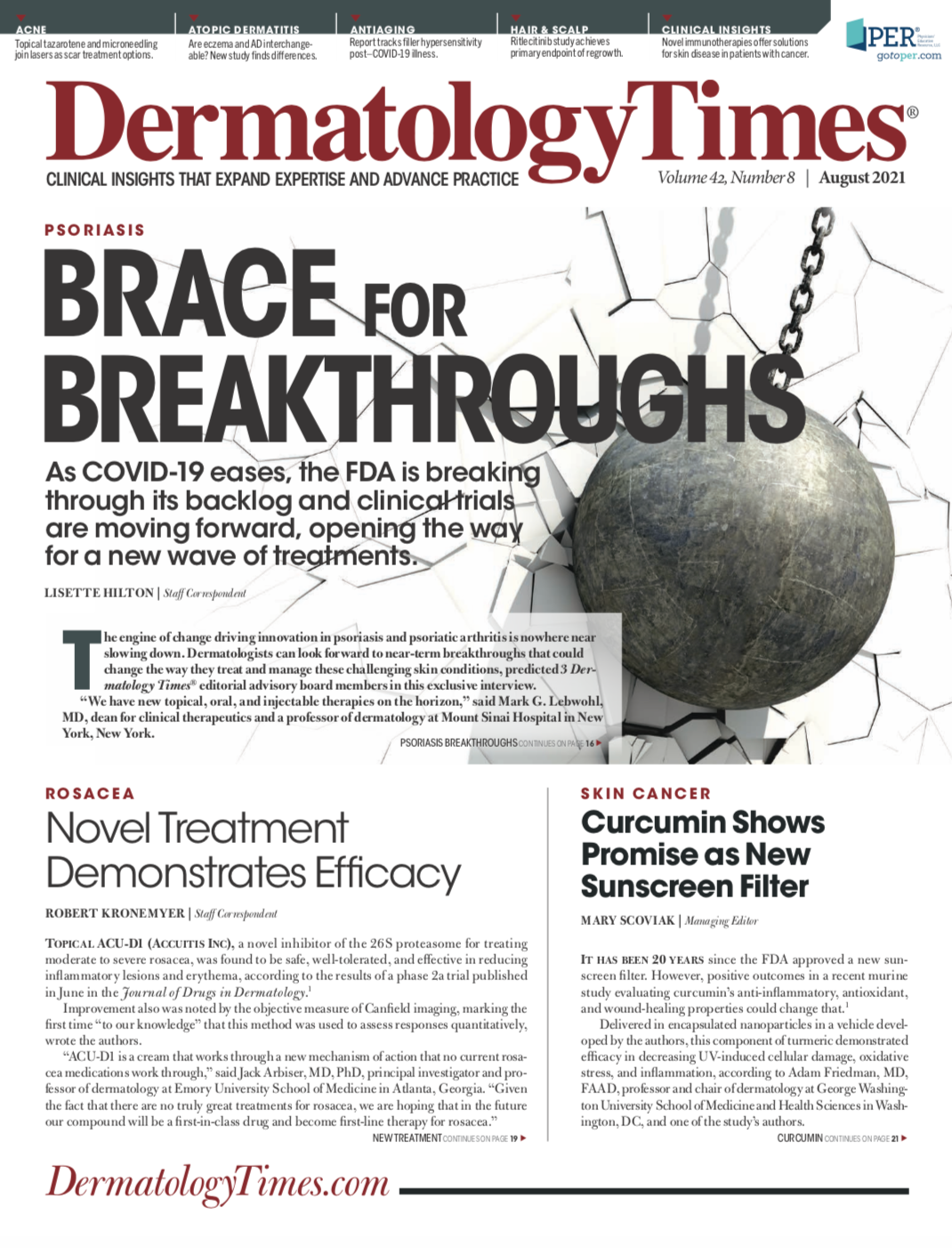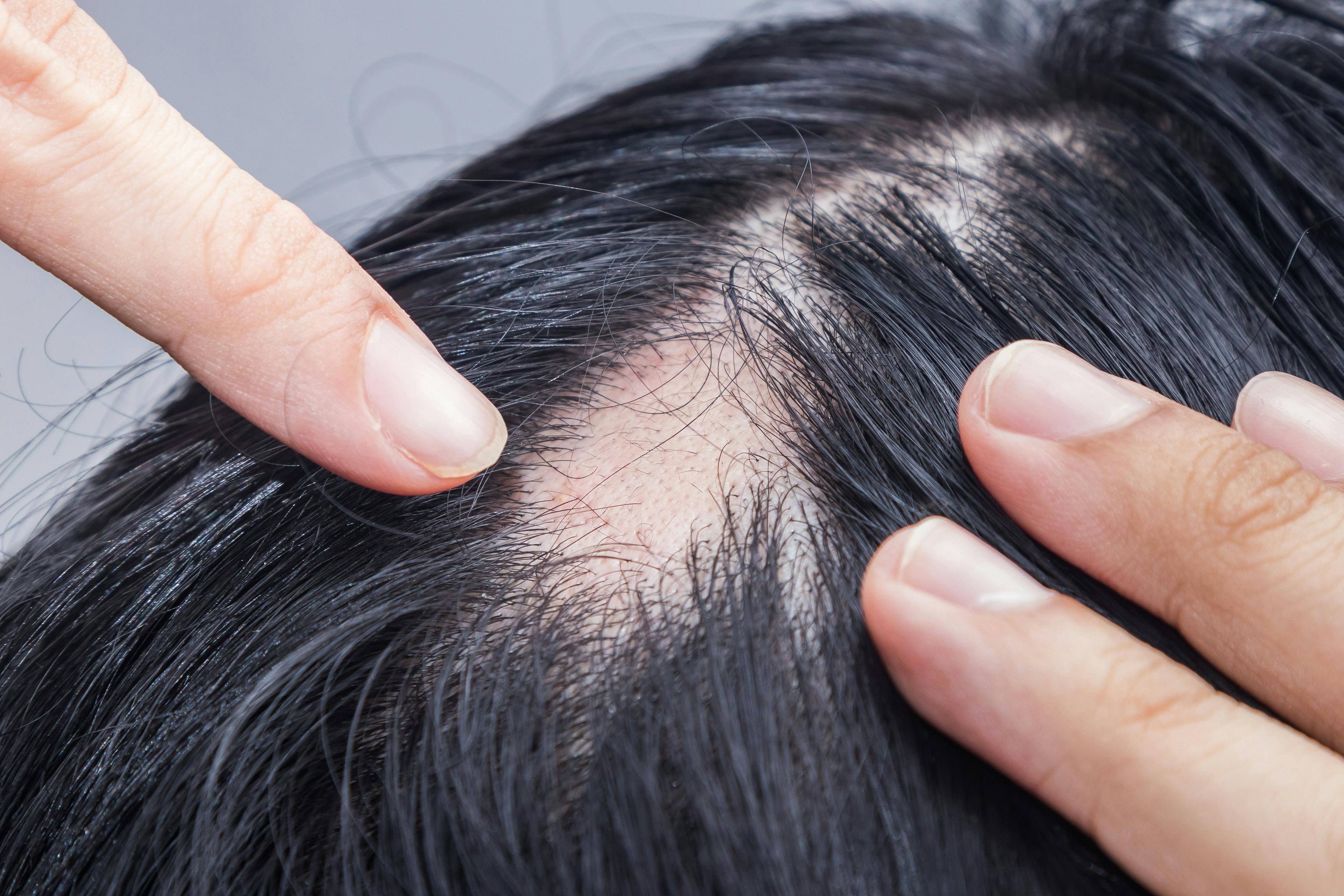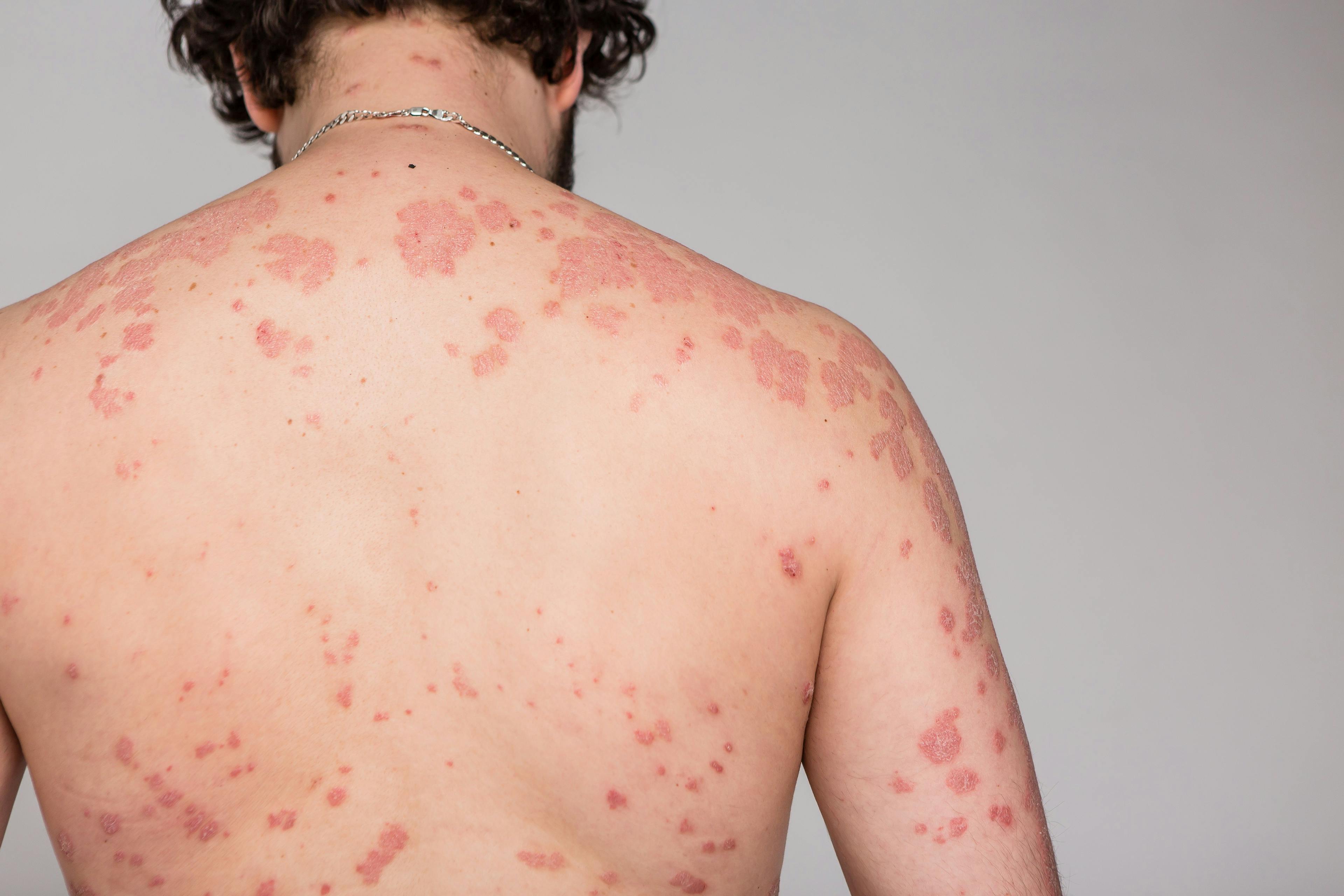- Acne
- Actinic Keratosis
- Aesthetics
- Alopecia
- Atopic Dermatitis
- Buy-and-Bill
- COVID-19
- Case-Based Roundtable
- Chronic Hand Eczema
- Chronic Spontaneous Urticaria
- Drug Watch
- Eczema
- General Dermatology
- Hidradenitis Suppurativa
- Melasma
- NP and PA
- Pediatric Dermatology
- Pigmentary Disorders
- Practice Management
- Precision Medicine and Biologics
- Prurigo Nodularis
- Psoriasis
- Psoriatic Arthritis
- Rare Disease
- Rosacea
- Skin Cancer
- Vitiligo
- Wound Care
Publication
Article
Dermatology Times
Novel Rosacea Treatment Demonstrates Efficacy
Author(s):
Novel inhibitor of the 26S proteasome was found to be safe, well-tolerated, and effective in reducing inflammatory lesions and erythema in patients with rosacea.
Topical ACU-D1 (Accuitis Inc), a novel inhibitor of the 26S proteasome for treating moderate to severe rosacea, was found to be safe, well-tolerated, and effective in reducing inflammatory lesions and erythema, according to the results of a phase 2a trial published in June in the Journal of Drugs in Dermatology.1
Improvement also was noted by the objective measure of Canfield imaging, marking the first time “to our knowledge” that this method was used to assess responses quantitatively, wrote the authors.
“ACU-D1 is a cream that works through a new mechanism of action that no current rosacea medications work through,” said Jack Arbiser, MD, PhD, principal investigator and professor of dermatology at Emory University School of Medicine in Atlanta, Georgia. “Given the fact that there are no truly great treatments for rosacea, we are hoping that in the future our compound will be a first-in-class drug and become first-line therapy for rosacea.”
ACU-DI, which is comprised of the organic compound pentaerythritol tetrakis 3-3,5-di-tert-butyl-4-hydroxyphenyl propionate, inhibits a pathway called nuclear factor kB (NF-kB), “which is a major inflammatory pathway in the skin,” Arbiser told Dermatology Times®. “To our knowledge, there are no other drugs topically on the market that do that. By blocking the 26S proteasome, we block NF-kB activation. NF-kB causes the cells in the skin to become inflamed and produce inflammatory cytokines such as interleukin-1 β (IL-1 β), IL-6, and IL-8. These cytokines are involved in many inflammatory diseases of the skin.”
The 14-week, randomized, double-blinded, placebo-controlled study was performed at 2 rosacea clinical trial sites: the University of Louisville in Kentucky and Forefront Dermatology in San Antonio, Texas.
A total of 40 adult subjects with moderate to severe rosacea, which was defined as 3 or 4 on the 5-point Investigator Global Assessment (IGA), were recruited for the study. At baseline/screening, all patients had at least 10 inflammatory lesions (papules and pustules) and at least 2 nodules on the face.
“Our study was a broad-ranging study in order to determine whether mild, moderate, or severe disease served as the best target for our drug,” Arbiser said. “Most rosacea studies are limited to severe disease.”
Patients were randomized to either ACU-D1 (n = 27) or comparator vehicle—a cream without the active ingredient (n = 13)—for twice daily application (morning and evening) on the face for 12 weeks.
Patients were instructed not to use any other therapies that might affect their rosacea, other than mild moisturizers and sunscreens.
Of the 40 patients recruited, 39 participated and 38 completed the study.
Apart from baseline/screening, patients were seen at weeks 2, 4, 8, 12, and 14.
The primary end point was the inflammatory count and IGA reduction, whereas secondary end points included percentage change from baseline in inflammatory lesion count at each visit, erythema reduction, IGA decrease, and local tolerability evaluations.
“On average, maximum efficacy of ACU-DI was achieved at 1 month, which was basically maintained throughout the study period,” Arbiser said. “However, the study was not powered for significance. Still, the findings were quite striking for redness.”
At 1 month, there was a 54% reduction in inflammatory lesions in the active arm compared with the control group. In the active arm, 93% of patients improved, of whom 81% improved by at least 25% and 67% by 50% or more.
“Even with the wide range of lesions, we saw a really nice decrease in lesion count in the active arm at 1 month,” Arbiser said. “In addition, often there is increased pigment with inflammation. But our cream appears to decrease the inflammatory pigment, which is a particular issue in patients of color because inflammation in this population often results in increased pigmentation left behind.”
At 12 weeks, ACU-D1 demonstrated efficacy in 92% (25 of 27) of patients in reducing inflammatory lesions and a 2 plus grade IGA increase of clear and near clear responses in 27% of patients.
The mean percentage reduction in inflammatory lesions at week 12 was 54% among patients applying ACU-D1. This reduction was significantly greater in patients with more severe disease—20 or more inflammatory lesions at randomization—with a mean percentage reduction of 59% in inflammatory lesions at week 12.
Surprising to the investigators was the positive effect ACU-D1 had on erythema from baseline to week 12 and the dramatic increase in the Clinician Erythema Assessment (CEA) of 0 (clear) and 1 (near clear) in the active group.
Erythema (net CEA reduction) was greatly decreased at the end of the study in the active arm compared with vehicle. The active subjects whose erythema decreased rose from 22% at day 1 to 58% at day 85 vs 33% at day 1 to 36% at day 85 among vehicle subjects.
A subset analysis revealed a 59% lesion count reduction in patients with moderate to severe lesion count in the active arm from day 1 to day 85. “A full 100% of these patients also improved overall at day 30, and this improvement maintained throughout the study,” Arbiser said.
At 14 weeks, the disease had not worsened from 12 weeks. “There is always the concern that when you stop rosacea therapy, flaring will occur. But we did not see that,” Arbiser said.
One of the innovative features of the study was using Canfield imaging. “This imaging allowed us to document a very nice decrease in redness compared [with] vehicle,” Arbiser said. “The advantage of using Canfield imaging is that it is not subjective and operative dependent like the other measures we use [for] rosacea. With Canfield imaging we were able to assess responses both qualitatively and quantitatively.”
The study authors believe using physical characteristics makes Canfield imaging less susceptible to investigator bias. They also predict that the imaging is likely to be used as an objective measure in the future to gauge the effectiveness of rosacea treatments.
Arbiser also noted that the safety profile of ACU-D1 is impressive. “No patient dropped out of the study because of [adverse] effects,” Arbiser said. “A few patients in both the active arm and vehicle arm reported some dryness and perhaps slight stinging. But those were the worst adverse events reported.”
Arbiser believes ACU-D1 provides several advantages over current medications for rosacea. “First of all, it works very quickly. We can see results in 1 to 2 weeks, which is very unusual for a skin drug,” he said. “ACU-D1 also reduces redness, which again is very uncommon for skin drugs. The only skin drugs that decrease redness are vasoconstrictors. However, vasoconstrictors often stop working or cause rebound. They are also extremely expensive, and often insurance will not pay for them.”
Although the twice-daily patient treatment protocol for ACU-D1 is standard for creams to treat rosacea, “the early onset of action that we observe with our drug should help with [adherence],” Arbiser said. “Often, if patients need to wait for months to see noticeable results, they may not adhere to the program, even though when we prescribe other rosacea medications we tell the patient it will take a long time to see some benefits.”
NF-kB is also found in other inflammatory skin diseases such as eczema and psoriasis. “In the future, we are going to target those diseases as possible other indications for ACU-D1,” Arbiser said. “We chose rosacea as the first indication because there is such a great unmet need for rosacea. There is very little innovation in the field.”
Further studies are warranted based on these initial positive results, according to the investigators. “One of the reasons we need to conduct a larger phase 2b study is to obtain significance,” Arbiser said. “Undertaking that study, [however], depends on whether Big Pharma is interested in acquiring us or whether we can raise the capital ourselves as a private company. At this point, we are open to either option.”
Commercialization of ACU-D1 is a minimum of 3 years away. “We expect to price the drug attractively so we can compete with current generic creams for rosacea,” Arbiser said. “We think we can convince insurers to pay for our cream, which is a challenge for a lot of our competition.”
Arbiser also believes the cream can sharply reduce the use of oral drugs such as antibiotics. “Antibiotics are the most commonly used systemic treatment of rosacea,” he said. “But the problem with antibiotics is that when the skin microbiome changes, [adverse] effects arise from the antibiotic.”
Increasing scrutiny over using oral antibiotics for noninfectious disorders is prompting novel therapies for rosacea that affect all components of the disease, according to Arbiser. “Traditionally, rosacea has been subdivided into 4 subtypes,” he said. “However, most patients manifest more than 1 subtype, thus we are evolving to a more phenotypic description of the disease.”
Disclosure:
Arbiser is the inventor of the compound used in ACU-D1 and cofounder of Accuitis Inc.
Reference:
1. Jackson JM, Coulon R, Arbiser JL. Evaluation of a first-in-class proteasome inhibitor in patients with moderate to severe rosacea. J Drugs Dermatol. 2021;20(6):660-664. doi:10.36849/JDD.2021.5925

Newsletter
Like what you’re reading? Subscribe to Dermatology Times for weekly updates on therapies, innovations, and real-world practice tips.




























